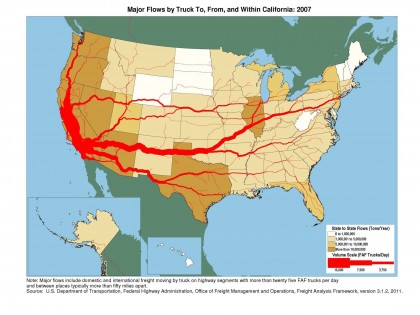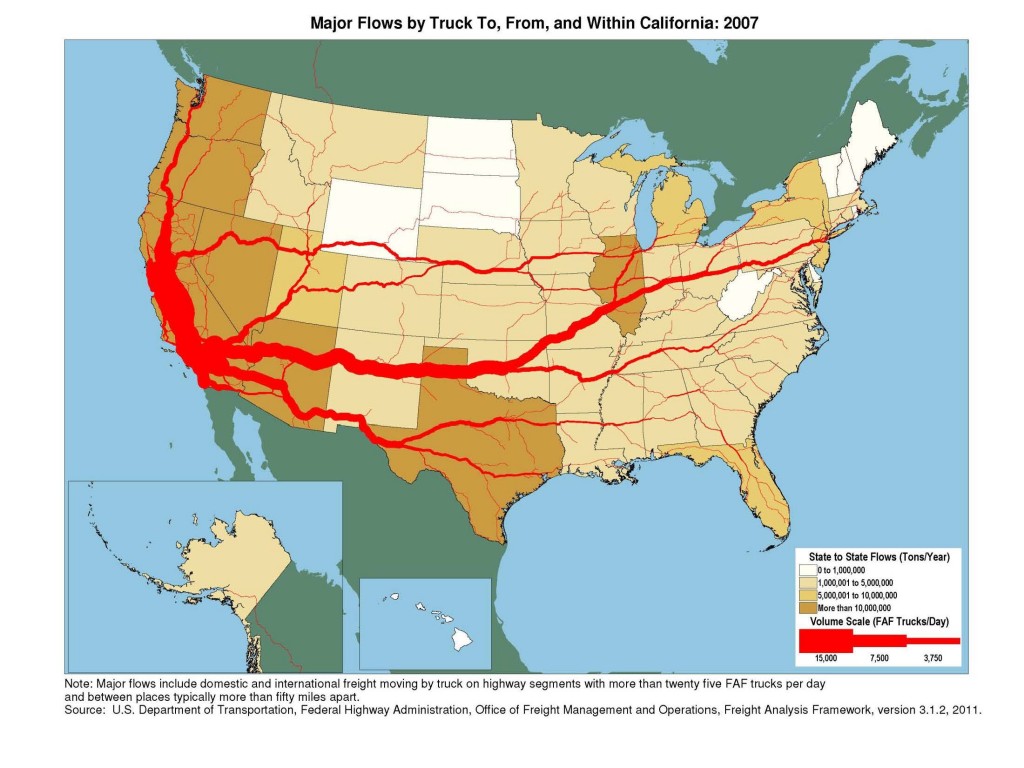Community advocates are asking for an on-dock, ship-to-rail loading alternative, instead of the SCIG/BNSF near-dock transfer facility that will draw trucks up and down the southern stretch of the I-710. The Transit Coalition is advocating for the GRID Project as an alternative – GRID includes an underground zero-emission freight rail system that would load containers at the ports and take them to warehouses or to outlying facilities that would transfer containers onto heavy rail for further shipment.
A brief tour of agendas:
From the south I-710-adjacent communities who continue to fight a freeway widening plan that will accommodate more trucks, and have succeeded in getting “Community Alternative 7” added to a recirculated draft I-710 Project EIR — to the north SR-710 communities along a proposed tunnel extension to the 210 who oppose that plan, contending that it will bring more trucks and traffic through northeast LA County and onto the 210 in both directions (they rebut recent assurances from the SR-710 technical team that there won’t be many additional trucks using the corridor in part by noting that the south/I-710 is being widened to accommodate more trucks!)…
From the webpages of the Ports of Long Beach and Los Angeles, promoting their respective efforts to reduce pollution related to freight transportation — to the San Gabriel Valley and Inland Empire, where Alameda Corridor East grade separation projects are underway so that freight trains don’t regularly jam vehicular traffic on local arterials causing more idling and pollution…
From the San Joaquin Valley, which suffers from poor air quality due in part to diesel particulates from trucks and trains — to Southern California AQMD headquarters in Diamond Bar which just hosted an April symposium on Transitioning to Zero-Emission Freight Transport Technologies at which Central Valley pollution sources, the I-710, port facilities, and lower or zero emission technologies for trucks and trains were discussed (and at which one audience member said to the panelists he was disappointed that no one was talking about downsizing trains for short-haul trips, and that the group was approaching the question of zero-emission technology with a “business as usual” attitude – big trains, big trucks – instead of smaller, electric freight trains)…
From Palm Desert, where the Southern California Association of Governments 2013 General Assembly is taking place today and tomorrow (the Executive Director’s report devotes two paragraphs to freight transportation policy) — to Sacramento where the UC Davis Policy Institute for Energy, Environment and the Economy and the Institute for Transportation Studies together with the Union of Concerned Scientists have convened a three-session forum Delivering the Green: The Future of California’s Freight Transportation System (this post’s graphic is from one of the presentations) at which panelists will address the role of a cleaner freight system in meeting air quality, climate, economic, and public health and community needs. Sacramento is also where Caltrans has begun to develop a State Freight Plan…
From Southern California, where the multi-county transportation coalition Mobility 21 works to mobilize regional support for transportation funding and legislative priorities at the federal and state levels — to Pennsylvania, whose Congressman Bill Shuster, Chairman of the House Transportation and Infrastructure Committee, told Mobility 21 2012 summit attendees that goods movement has to be a top national priority (Shuster was breakfast keynote speaker)…
From the coast of Mexico, where planned ports that would compete with San Pedro are looking for capital investment and links to a NAFTA superhighway up through Texas — to New York, which has its own struggles with waterfront modernization and labor issues but where the NY Times just published a feature on the Long Beach/Los Angeles SCIG controversy here!…
From Cal State Long Beach, where its Center for International Trade and Transportation will hold a May 15 Town Hall Meeting on Efficiency and Competitiveness: Securing Cargo and Jobs — to the U.S. House of Representatives, where a 21st Century Panel on Freight Transportation has just been formed and tasked with examining the current state of freight transportation in the United States and improving ways to strengthen the U.S. economy through an efficient intermodal freight network (and which will be holding a field hearing in Los Angeles soon)…
The overarching issues behind all these agendas are jobs, investment, economic efficiency and regional/national competitiveness, the environment, and new technologies for trucks and rail systems.
The SCIG Project promoters stress its benefits in these areas, but while eventual zero-emission trucks may reduce pollution, keeping lots of trucks on the road poses safety and congestion problems. A truck-centered approach to moving goods labeled the SR-710 a “natural goods movement corridor” some years ago, and continues to pose policy, safety, and environmental problems today. Some on-dock rail facilities are already being built at our local ports, and new approaches that put freight from the ports directly onto electrified rail for short trips could greatly mitigate urban congestion while reducing the need for land near the ports and opening it up for other, community-friendly uses.


